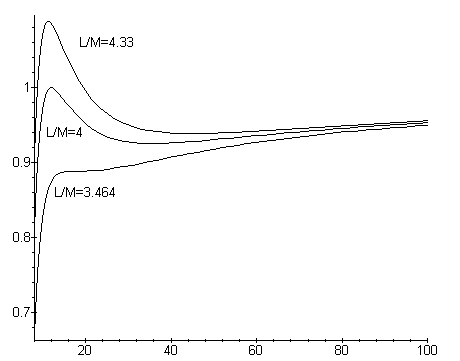
Plot of Effective potential vs. radius
What's different about these two orbits?
As the above Applet demonstrates gravity described by a Newtonian central force and the motion near a black hole described by Einstein's theory of general relativity differ qualitatively. The Newtonian orbits are closed and the orbits in Einstein's theory are not. Some of our confidence in Einstein's theory comes from direct observation of this effect in the orbit of Mercury (the effect is slight and observations over many years are required to measure it).
In general relativity the motion of a particle near a black hole is not given by a force equation. Einstein's theory describes the gravitational effect of mass as a curvature of the spacetime. The orbiting body moves with no outside forces acting on it in a "straight line" (or geodesic). However in a curved space a "straight line" is not straight but curved and the result is the orbit seen above.
The curvature of the space also gives rise to a complication in interpreting the radius shown in the applet. In a black hole of the type modeled here a sphere with area 4 Pi R2 is not a distance R from the origin! (However this is the radial coordinate commonly used for describing such black holes and the coordinate use as "radius" in the applet). In a similar fashion the time used in the evolution of the orbit is the time experienced by an observer travelling with the orbiting body and not that of someone watching from afar.
If there's no "force" then how do we find the effective potential? The answer is that we solve for the equation of a "straight line" in the curved space around the black hole (to be technical we solve for timelike geodesics). It just happens that the resulting equation can be written in the same form as the energy equation used for central forces. Plots of the resulting effective potential are shown below for various value of L/M, L the angular momentum and M the mass of the black hole.

Plot of Effective potential vs. radius
Unlike the Newtonian effective potential this potential is negative for small values of R. Note also that the potential has a maximum which corresponds to an unstable circular orbit. Finally, for values of L/M less than 3.464 there is no minimum in the potential and all objects fall into the black hole (in Newtonian gravity if you have any angular momentum you cannot reach R=0 - not so for black holes...)
You can investigate these plots and the behavior of objects in various forces by using...the Orbit Applet
or look at the source code
This page created by Peter Musgrave musgrave@astro.queensu.ca